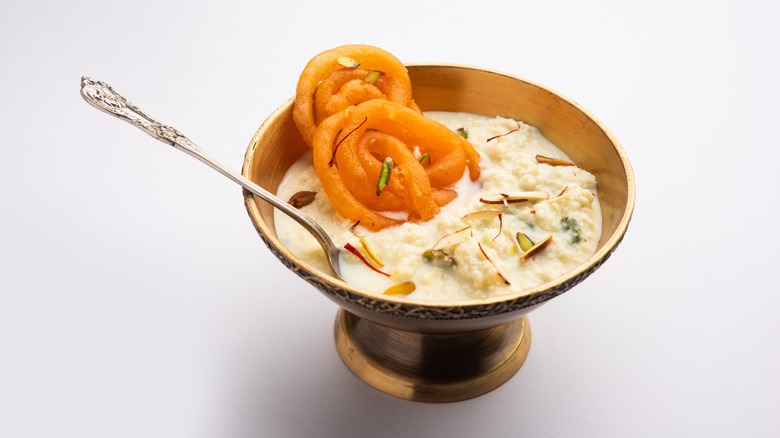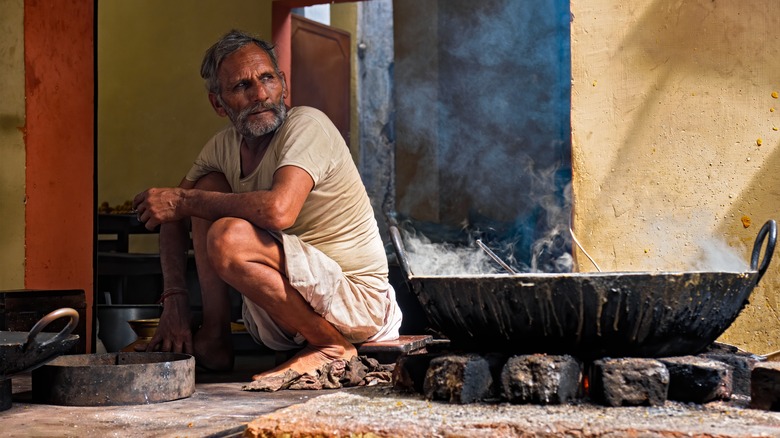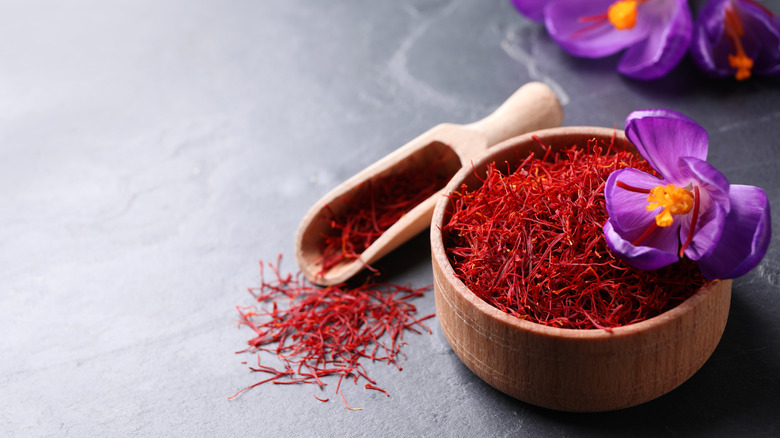The Thick And Creamy North Indian Dessert Served At Celebrations
Indian cuisine is known for its festival dishes. From dahi bhalla, the deep-fried lentil fritters served at Holi, to rasgulla, the sweet and spicy dumplings nibbled at Diwali, a big part of any special occasion is the food and flavors (via Dwaraka Organic).
Rabdi (also known as rabri) is another beloved celebration dish. Although its name means "porridge" (via Urdu Point), it is actually a dessert that can be served warm or chilled. It is classed as North Indian, and supposedly originated in Mathura (via Kitchen to Table with Nitu). It's also very popular in West Bengal, a state famous for its Indian sweets. In fact, rabdi's roots go way back, with mentions of it even showing up in 15th-century epic poetry (via Get a Recipes). But why has it stood the test of time so well?
Most likely because it's such a comforting and indulgent combination. Typically, rabdi includes sweetened milk, clotted cream, cardamom, saffron, dried fruits, and nuts such as almonds and pistachios (via Dassana's Veg Recipes). The result is sugary and soothing, with the piney cardamom, and earthy saffron, adding depth and complexity. Yet surprisingly, this wholesome and innocent milk pudding was banned from Kolkata altogether in the 1960s.
Why was rabdi forbidden in India?
According to Economic Times, due to a dairy shortage in West Bengal, authorities wanted to curb any excessive use of milk, including in desserts like rabdi. Unfortunately for the poorer people in Kolkata, simple puddings were one of the few pleasures they could enjoy. As a result, there was an outcry from both citizens and sweet shops, followed by riots. Eventually, the ban was overturned, its unpopularity arguably contributing to the ruling party losing the next election. But for a while, rabdi enjoyed a reputation as an outlaw on the black market.
And nowadays, it is even the economic backbone of Rabrigram, a rustic West Bengal village named in its honor. So much so that when you approach the outskirts, you are greeted by the wafting scent of boiling milk (via Slurrp). In fact, rabdi is the main cottage industry for the residents, with around 50 to 60 families minding big simmering pots of it each day (via Get Bengal). And according to Partners in Crave, most of the rabri eaten in Kolkata is sourced from here.
But how do you make this milky dessert? Rabdi is actually relatively simple, but it does take time, care, and attention. This isn't a "sling everything together and stick it in the fridge" number, it's more a grandma-at-the-stove treat. Yet it's also rewarding for that very reason.
Here's how to make classic rabdi
Dassana's Veg Recipes outlines a traditional rabri recipe. Essentially, you reduce full-fat milk on a low to medium heat for roughly an hour, without letting it boil. During the cooking process, the top layer of milk will froth and thicken into a clotted layer known as "malai." You should gather this gently with a spatula and set it aside several times during the process, as you'll mix it in later to add creaminess and crunchiness.
Once the milk has thickened into a pudding consistency — around a quarter to a third of its original amount — you'll add sugar, cardamom, and saffron (which will turn the radbi to a golden shade). Next, stir in the malai, as well as almonds and pistachios that have been sliced and blanched. Finally, add a teaspoon of either rose water or kewra water for floral notes. Garnish with leftover nuts, then serve warm or chilled.
While rabdi is a lovely standalone dish, you can also drizzle it over gulab jamun (syrupy sponge balls), and malpua (Indian pancakes). Plus you can turn it into shahi tukada, a royal Mughlai sweet of bread slices deep-fried in ghee (via Essence of Life). And in the unlikely event you end up with leftover rabdi? Swasthi's Recipes recommends pouring it into molds and freezing it to make kulfi, a traditional Indian ice cream. Serve with sliced mango and you've turned this creamy comfort pudding into a light, summery — and very yummy — dessert.


